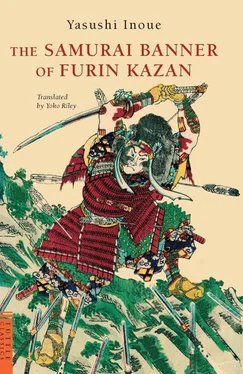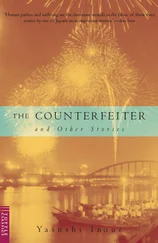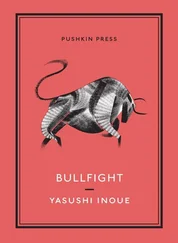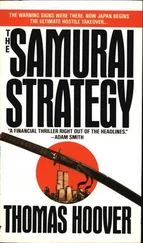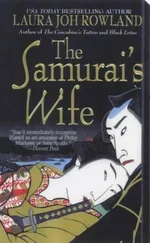When Kansuke came out of the gates of Itagaki’s residence, he saw Harunobu’s wife Sanjo-no-Uji. Kansuke was alarmed, because it was quite evident why she was there. Kansuke stopped at the gate and bowed to her.
“Kansuke, I met you at the right place. I heard that you brought a woman with Suwa blood into the city and you were hiding her here. Is it true?”
“Yes, it is true,” Kansuke answered vaguely.
“If she is a hostage, you should treat her as a hostage. I shall not allow you to treat her as anything more.”
Kansuke saw the flame of jealousy in her eyes and said, “If you mean whether she is a hostage from Suwa, yes, she is. I am looking after her.”
“Will you let me see her?”
Kansuke felt that he should not allow her to do so and said quickly, “Since the yard was not cleaned this morning, could you wait a while?”
Kansuke bowed to her and went back to the residence where Princess Yuu was hidden and asked her hastily.
“Princess Yuu, would you please hide yourself somewhere?”
“Why do I have to hide myself?” she asked quietly.
“The consort of the lord is here.”
“I shall meet her then.”
“It is better if you do not see her, Princess.”
“Why not? Isn’t it she who should feel guilty meeting me?
Since I am the one whose father was killed by her husband.”
Kansuke knew that he could not change her mind. Though her family was destroyed, her strong bloodlines still motivated her. Her eyes were clear and her cheeks were filled with excitement.
Kansuke observed her with admiration. He suddenly realized what propelled her strength; it was her competitiveness toward Harunobu’s wife.
“Fine, I shall bring the lord’s consort here,” Kansuke said without changing his expression.
Kansuke left and soon returned accompanying Sanjo-no-Uji and her maids. Sanjo-no-Uji came close to the veranda.
“Is she the daughter of the Suwa?” she said haughtily and looked down at Princess Yuu who sat there bowing slightly. “So, she came all the way from Suwa wishing to be the concubine of the man who killed her father! Well, I am glad that it was not our family who was destroyed!” saying this Sanjo-no-Uji turned and left.
Princess Yuu remained in the same stance for a while, even after the Sanjo’s group had left; then she lifted her face and said to Kansuke, “Yes, she is lucky that it was not her family who was destroyed.” After a while she continued determinedly, “Kansuke, as you suggested, I should intermingle the blood of the Suwa in the family of Takeda. I don’t have the slightest idea what that will do, but after all, this could be the reason that I survived.”
Suddenly tears filled her eyes and ran down her cheeks. Kansuke watched her in silent amazement.
After Harunobu destroyed the Suwa family, he started to attack the neighboring areas using Suwa as his base. By the third month of the fifteenth year of Tenbun, he had started a campaign to attack Toishi Castle in Shinano Province and faced the army of Murakami Yoshikiyo. Murakami was the leader of a powerful family of northern Shinano and resided in Katsurao Castle.
Toishi Castle also belonged to him.
When Harunobu left the castle town of Kofuchu, it was the eighth day of the third month, the hour of the sea horse. 32Cherry blossoms had already fallen, and the spring sunshine made the Takeda’s warriors feel quite hot.
It was the Takeda’s tradition to carry two banners when entering a large battle. Both of them were treasures of the house; they were called Suwa Hossho 33and Sonshi Niryu . 34
The two banners were fluttering in the spring breeze. One banner, Suwa Hossho, was red and said in gold writing “Suwa, descendant of the Great Kami . 35” The other banner, Sonshi Niryu, 36also had gold writing, but on a background of dark blue:
“Be as swift as the wind, be as thoughtful as the forest, attack as fiercely as fire, and be as composed as the mountain” ( Fu-Rin-Ka-Zan 37). Both vertical banners were about four meters in length.
On both sides of these banners, warriors carried small replicas of the banners attached to their backs. The army marched day and night, passing Lake Suwa and then proceeding north. Two days later they were at Komuro.
In preparation for the attack on Toishi Castle, Harunobu divided his armies into four groups and placed them in strategic areas to prevent any incursions by the four neighboring enemies.
Harunobu himself, along with the remaining 4,000 samurai, marched to attack the castle.
Toishi Castle was small, set on a mountainside, and quite easy to destroy, but Murakami’s army would be coming to assist the army defending the castle. Because of this, Harunobu would have to divide his army into two groups, one, which would attack the castle, and the other, which would stop the reinforcing army.
Just before the attack on the castle, Harunobu’s army heard news of the arrival of 76,000 samurai under the leadership of Murakami. Each of the groups led by the Takeda’s leaders Amari, Oyamada, and Yokota fought to stop Murakami’s army on the northern side of the castle. Having no time to consider his actions, Harunobu had to start the attack by leading the main group from the west side of the castle.
Yamamoto Kansuke was placed in Harunobu’s main group with twenty-five samurai to hold the area.
As soon as the battle began, Kansuke felt that the outlook was not in their favor. It was an unreasonable war to start with, and furthermore, their small army was divided into two.
If General Itagaki, who was closest to the Takeda, were there, he would have asked Itagaki to suggest to Harunobu that falling back was probably the best course of action. But Itagaki was leading a troop to protect Suwa. If Harunobu had asked Kansuke’s opinion, he would have suggested retreat. But Harunobu did not ask him, so the battle continued unabated.
The armies of Amari, Yokota, and Oyamada were all on the defensive from the beginning, being outnumbered two to one.
One samurai who stood out among the enemy was Kojima Gorozaemon who was well known even in Takeda’s Province of Kai as a bold and fierce warrior. He was riding an exceptionally large horse and wielded a huge spear with ease.
Even though he was the enemy, the Takeda’s warriors admitted that his performance was outstanding. Aiming at this fierce warrior, a young samurai from the Takeda army spurred his horse on.
Compared to Kojima, he looked terribly small. He was a young samurai who was the twenty-three-year-old adopted son of Yokota Bichu-no-kami Hikojiro. They exchanged blows several times and becoming interlocked, they both fell from their horses. After a short but fierce battle one blood-covered samurai stood up. Upon closer view it appeared that it was young Hikojiro. It was an extraordinary fight and nobody expected Hikojiro to prevail.
His great achievement was reported to headquarters at once.
“He killed Kojima Gorozaemon!”
This news seemed to impress Harunobu, and he took this as a good omen.
“What does that do for us killing just Kojima Gorozaemon?”
Kansuke asked him. As for Kansuke, it seemed to be stupid for them to praise man-to-man combat. Even a widely reputed great samurai could die all too quickly in a battle like this. How could anyone rely on individual skills of swordsmanship? Kansuke felt that everybody was missing the point at the most important time of the battle.
Kansuke’s words sounded conceited to Harunobu.
“Killing Kojima Gorozaemon is like killing one hundred warriors,” Harunobu said.
“It is dangerous,” Kansuke uttered. Nobody around him understood the meaning of his words.
“What is dangerous?” inquired Harunobu.
Читать дальше
